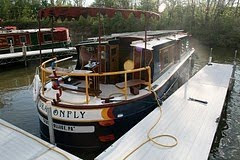 |
| A prairie bouquet |
But a little knowledge can be a depressing thing. As a former biologist, I know enough about plants to know that most of the "wildflowers" I've picked so far are not exactly wild.
The staples of a roadside floral display--Queen Anne's lace, butter and eggs, birdsfoot trefoil, cow vetch, red clover--they're non-natives, exotics, invaders, brought here from Europe or from Asia, deliberately or accidentally.
The staples of a roadside floral display--Queen Anne's lace, butter and eggs, birdsfoot trefoil, cow vetch, red clover--they're non-natives, exotics, invaders, brought here from Europe or from Asia, deliberately or accidentally.
But as we've moved farther west--away from the regions that have been settled the longest--it's become easier to find roadside flowers that are not, at heart, weeds. In Wisconsin, not only did we find plant communities that were mostly native species, but we were edging into a floristic zone that (for someone raised in the East) held many excitingly new plants--prairie species.
 |
| What is it? Check your smartphone-- there's an app for that! |
The docent behind the visitor center desk adjusted her glasses and sized us up. "You look reasonably young and fit," she said. "How about a six-mile hike?"
She grabbed a map and a pen and enthusiastically marked a route for us, narrating the different habitats we would pass through along the way: moist prairie, dry prairie, savannah, woodland, and so on.
It was a picture postcard day: blue skies, not too hot, a little breeze. The route our guide had laid out took us upslope and down, a pleasant, not oppressive, workout for our boat-cramped muscles.
And the flowers! Who knew there were so many permutations of yellow, daisy-shaped flowers? Ragworts and coneflowers and sunflowers, compass plant and prairie dock and coreopsis and black-eyed susan. Not to mention the profusion of goldenrods in every possible conformation.
Butterflies were out in full force, enjoying the nectar: deep purple admirals, big and showy; the smaller fritillaries, looking appropriately autumnal in orange and brown; the occasional tiger swallowtail; buckeyes flashing their wingspots.
 |
| A replica of a sod house, such as prairie settlers once built. Notice the green roof! |
Have you ever visited a science museum with a butterfly aviary? Where you tiptoe through double doors into a room full of butterflies, swirling around you in colorful clouds?
That's what it was like . . . except this wasn't a manmade habitat, contained behind glass. It was the real world, in all its natural exuberance, functioning normally.






No comments:
Post a Comment